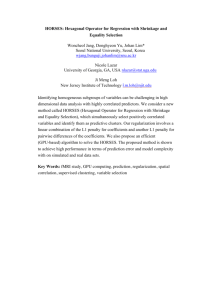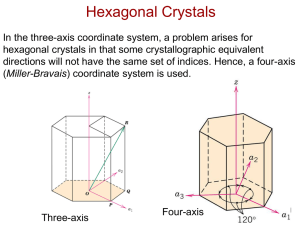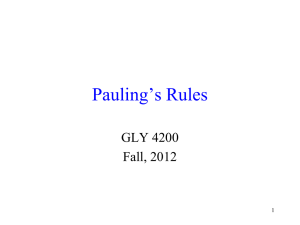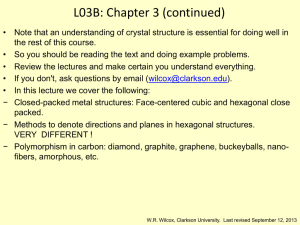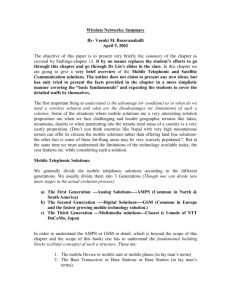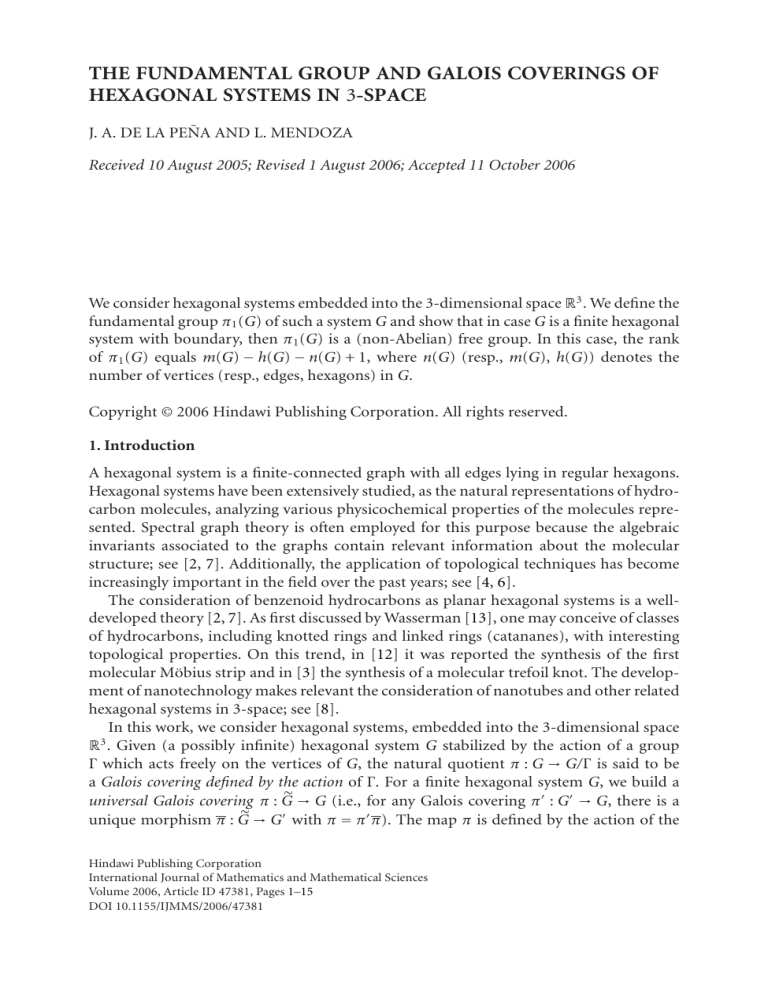
THE FUNDAMENTAL GROUP AND GALOIS COVERINGS OF
HEXAGONAL SYSTEMS IN 3-SPACE
J. A. DE LA PEÑA AND L. MENDOZA
Received 10 August 2005; Revised 1 August 2006; Accepted 11 October 2006
We consider hexagonal systems embedded into the 3-dimensional space R3 . We define the
fundamental group π 1 (G) of such a system G and show that in case G is a finite hexagonal
system with boundary, then π 1 (G) is a (non-Abelian) free group. In this case, the rank
of π 1 (G) equals m(G) − h(G) − n(G) + 1, where n(G) (resp., m(G), h(G)) denotes the
number of vertices (resp., edges, hexagons) in G.
Copyright © 2006 Hindawi Publishing Corporation. All rights reserved.
1. Introduction
A hexagonal system is a finite-connected graph with all edges lying in regular hexagons.
Hexagonal systems have been extensively studied, as the natural representations of hydrocarbon molecules, analyzing various physicochemical properties of the molecules represented. Spectral graph theory is often employed for this purpose because the algebraic
invariants associated to the graphs contain relevant information about the molecular
structure; see [2, 7]. Additionally, the application of topological techniques has become
increasingly important in the field over the past years; see [4, 6].
The consideration of benzenoid hydrocarbons as planar hexagonal systems is a welldeveloped theory [2, 7]. As first discussed by Wasserman [13], one may conceive of classes
of hydrocarbons, including knotted rings and linked rings (catananes), with interesting
topological properties. On this trend, in [12] it was reported the synthesis of the first
molecular Möbius strip and in [3] the synthesis of a molecular trefoil knot. The development of nanotechnology makes relevant the consideration of nanotubes and other related
hexagonal systems in 3-space; see [8].
In this work, we consider hexagonal systems, embedded into the 3-dimensional space
R3 . Given (a possibly infinite) hexagonal system G stabilized by the action of a group
Γ which acts freely on the vertices of G, the natural quotient π : G → G/Γ is said to be
a Galois covering defined by the action of Γ. For a finite hexagonal system G, we build a
universal Galois covering π : G → G (i.e., for any Galois covering π : G → G, there is a
unique morphism π : G → G with π = π π). The map π is defined by the action of the
Hindawi Publishing Corporation
International Journal of Mathematics and Mathematical Sciences
Volume 2006, Article ID 47381, Pages 1–15
DOI 10.1155/IJMMS/2006/47381
2
The fundamental group of hexagonal systems in 3-space
fundamental group π1 (G). This group π1 (G) is also the fundamental group of the CWrealization cw(G) of the hexagonal system G.
We say that an edge e in G is on the boundary if e belongs only to one hexagon in G.
In case G has no boundary and cw(G) is orientable, a well-known argument implies that
cw(G) is a topological torus and therefore π1 (G) = Z × Z (see Proposition 2.1). For the
case with boundary, we will prove the following result.
Theorem 1.1. Let G be a finite hexagonal system with boundary, then π1 (G) is a (nonAbelian) free group.
In the case considered in the above theorem, the rank of π1 (G), denoted by rk(G),
is an important invariant of the hexagonal system. The rank rk(G) can be numerically
obtained from the number of vertices n(G), the number of edges m(G), and the number
of hexagons h(G) of G, in the following way.
Theorem 1.2. Let G be a finite hexagonal system with boundary. Then
rk(G) = m(G) − h(G) − n(G) + 1.
(1.1)
The proof of Theorem 1.2 follows from some simplicial homology arguments and is
given in Section 3. In Section 4, we consider the simply connected case, that is, rk(G) = 0
and show that G is equivalent to a planar graph.
The results reported in this work will be used in forthcoming papers to describe the
general structure of finite hexagonal systems with boundary and calculate its momenta,
π-electron energy, and other important invariants.
The reader is referred to [6, 10] for an algebraic topology background and terminology
not explained in the paper.
We denote by Z and Q the additive group of integers and the rational number field,
respectively.
2. Galois coverings and the fundamental group
2.1. A hexagonal system G = (G0 ,G1 ,Ᏼ(G)) is given by a set of vertices G0 , a set of edges
G1 ⊂ G20 , and a set Ᏼ(G) ⊂ G61 of hexagons, satisfying the following:
(H1) each edge e = {x, y } ∈ G20 satisfies x = y and belongs to a hexagon (i.e., there is
e ∈ G51 with (e,e ) ∈ Ᏼ(G));
(H2) each vertex x ∈ G0 belongs to at most 3 edges in G (i.e., the degree d(x) ≤ 3);
(H3) each hexagon {e1 ,e2 ,...,e6 } is formed by pairwise different edges with ei ∩ ei+1 a
single vertex, for i = 1,...,6 and e7 = e1 . Moreover, two hexagons have at most
one edge in common.
We write {e1 ,e2 ,...,e6 } for elements of Ᏼ(G) and get the drawing in Figure 2.1. Observe that not necessarily for any sextuple {e1 ,...,e6 } ∈ G61 with ei = {xi ,xi+1 } ∈ G20 and
x7 = x1 , we get a hexagon in G.
2.2. Examples of hexagonal systems.
(1) Planar graphs associated to benzenoid hydrocarbons (see, e.g., Figure 2.2).
J. A. De La Peña and L. Mendoza 3
e1
e6
e2
e5
e3
e4
Figure 2.1
H
H
C
C
H
C
C
C
H
H
C
C
C
H
C
C
H
H
G =
(a)
(b)
Figure 2.2
¼
1
1
2
2
¼
1
1
2
2
¼
(a)
¼
(b)
Figure 2.3
(2) Cylindrical tubes associated to nanotubes (identifying vertices with the same number). (See Figure 2.3.)
In (a), there are exactly 3 hexagons in G. The closed walks of length 6 forming the
mouths of the cylinder are not hexagons in the system.
In (b), there are exactly 6 hexagons in G. Besides the 5 planar hexagons, there is an
additional one formed by identifying 1 ↔ 1 and 2 ↔ 2 .
(3) We will schematically draw cylinders as shown in Figure 2.4. In this case, the cylinder has n half-twists. In case n is odd, the cylinder is called a Möbius band.
(4) The torus is obtained by identifying the vertices and the edges indicated in Figure
2.5. All the 6-edge contours formed are hexagons in the torus.
4
The fundamental group of hexagonal systems in 3-space
Figure 2.4
1
α
β
γ
λ
1
2
2
3
3
4
4
1
α
(a)
β
γ
λ 1
(b)
Figure 2.5
1
3
2
2
G=
1
3
6
7
4
4
5
5
6
7
(a)
(b)
Figure 2.6
(5) The following hexagonal system is better understood by looking at the associated
CW-complex shown in Figure 2.6.
2.3. Given a hexagonal system G = (G0 ,G1 ,Ᏼ(G)), we consider an embedding ξ : G R3
where for each edge e = {x, y }, the image ξ(e) is a differentiable curve and two edges ξ(e)
and ξ(e ) intersect only in the image ξ(x) of a common vertex x of e and e .
J. A. De La Peña and L. Mendoza 5
We recall that two homeomorphisms f : R3 → R3 and g : R3 → R3 are isotopic if there
is a continuous function H : R3 × [0,1] → R3 such that H(x,0) = f (x), H(x,1) = g(x) for
every x ∈ R3 and H(x,t) is a homeomorphism for each fixed t ∈ [0,1]. It is known that
either f is isotopic to the identity or to a reflection function. In the first case, f is said to
be orientation preserving; in the second case, f is said to be orientation reversing.
Two embeddings ξ : G R3 and η : G R3 are equivalent if there is an orientation
preserving homeomorphism f with f ξ = η. See [4] for a careful discussion.
The construction of a CW-complex cw(G) associated to an embedding ξ : G R3 is
fulfilled by fixing {ξ(x) : x ∈ G0 } as 0-skeleton, {ξ(e) : e ∈ G1 } as 1-skeleton, and giving a
set of differentiable functions {mh : [0,1]2 R3 : h ∈ Ᏼ(G)} satisfying
∂ mh [0,1]2
= mh ∂ [0,1]2 = ξ(h),
(2.1)
where the image of mh and mh may only intersect on ξ(e) for an edge e common to h
and h . Clearly, the homotopy class of cw(G) depends only on the equivalence class of
ξ : G R3 .
We will say that the hexagonal system G is orientable if the associated CW-complex
cw(G) is orientable, that is, there is a differentiable vector field Ω : cw(G) → R3 \ {0}. It is
well known that G is orientable if and only if cw(G) does not contain a Möbius band.
Proposition 2.1. Let G be a hexagonal system without boundary and assume G is orientable. Then G is a torus.
Proof. Assume that G has no boundary, then d(x) = 3 for every x ∈ G0 . Then each edge
belongs to 2 hexagons and each vertex to 3 hexagons, that is,
1
2
h(G) + n(G) − m(G) = m(G) + m(G) − m(G) = 0.
3
3
(2.2)
The compact orientable surface cw(G) is homeomorphic to the sphere (n = 0) or to a
torus with n holes, n ≥ 1. The Euler formula for the characteristic of cw(G) yields
2 − 2n = χ cw(G) = n(G) − m(G) + h(G) = 0.
Hence n = 1 and G is a torus.
(2.3)
2.4. Let G be a connected hexagonal system. Fix (s,t) an orientation of the edges of G,
e
that is, for each e = {x, y } ∈ G, we have an arrow s(e) −→ t(e), and the inverse arrow
e−1
t(e) −−→ s(e).
We will construct the fundamental group π1 (G).
Fix a vertex x0 ∈ G0 . Consider the group W(G,x0 ) of all closed walks in G starting and
ending at x0 (the trivial walk τx0 is the identity). Define a homotopy relation ∼ in W(G,x0 )
generated by the following.
(a) If e = {x, y } ∈ G1 , then ee−1 ∼ τt(e) and e−1 e ∼ τs(e) .
6
The fundamental group of hexagonal systems in 3-space
(b) If {e1 ,...,e6 } ∈ Ᏼ(G), choose εi ∈ {1, −1} such that e1ε1 e2ε2 · · · e6ε6 is an oriented
path; then
εi+1
ε
ε ε
· · · e66 e11 · · · ei−i−11 ∼ τai ,
eiεi ei+1
(2.4)
where ai ∈ {s(ei ),t(ei )}.
(c) If u ∼ v, then wuw ∼ wvw , whenever the products make sense.
We define π1 (G,x0 ) = W(G,x0 )/ ∼ the set of homotopy classes of closed walks at x0 .
Clearly, π1 (G,x0 ) inherets the group structure of W(G,x0 ) and moreover, it does not depend on the chosen vertex x0 . We set π1 (G) for π1 (G,x0 ).
The following is a more precise version of Theorem 1.1 stated at the introduction.
Theorem 2.2. Let ξ : G R3 be an embedding of the hexagonal system G. Consider the
CW-complex cw(G) and the fundamental group π1 (G) associated to G. Then,
(a) π1 (G) is the fundamental group of cw(G),
(b) if G has boundary, then π1 (G) = π1 (ΔG ) is the fundamental group of a graph ΔG ,
and therefore π1 (G) is a (non-Abelian) free group.
Proof. (a) is clear from the definitions.
(b) A generalized hexagonal system G = (G0 ,G1 ,Ᏼ(G)) satisfies d(x) ≤ 3 for each x ∈
G0 and two hexagons in Ᏼ(G) have at most one edge in common (i.e., G satisfies conditions (H2) and (H3)). We will show, by induction on h(G), that for a generalized hexagonal system G with boundary, there exists a graph ΔG such that π1 (G) = π1 (ΔG ) is a free
group.
If h(G) = 0, then G is a graph and by classical theory, π1 (G) is free of rank m(G) −
n(G) + 1.
Assume h(G) ≥ 1. Since G has boundary, we choose a hexagon h ∈ Ᏼ(G) with edges
ei = {xi ,xi+1 } for 1 ≤ i ≤ 6 and x7 = x1 such that e1 ,...,e j only belong to the hexagon h,
and d(x j+1 ) = 3.
We consider the graph G with vertices G0 \ {x2 ,...,x j }, edges G1 = G1 \ {e1 ,...,e j },
and Ᏼ(G ) = Ᏼ(G) \ {h}. Then G is a generalized hexagonal system with h(G ) < h(G).
By induction hypothesis, π1 (G ) = π1 (ΔG ) is a free group.
Choose x0 a vertex in G . We will define a group homomorphism
ρ : W G,x0 −→ W G ,x0 ,
(2.5)
for a fixed orientation (s,t) of G and the induced orientation in G . Indeed, let w =
εm
b1ε1 b2ε2 · · · bm
∈ W(G,x0 ) be a closed path at x0 , according to the orientation (s,t). In case
bi = e for every 1 ≤ i ≤ m and 1 ≤ ≤ j, then ρ(w) = w ∈ W(G ,x0 ) is well defined.
Otherwise, we may assume w = w3 w2 w1 with w2 = eα · · · eiαi for 1 ≤ i < ≤ j and w1 ,
−α+1
−α
3
· · · ei−1i−1 w 1
w do not contain any arrow of the form ekαk , 1 ≤ k ≤ j. Then, ρ(w) = w3 e+1
∈ W(G ,x0 ) is well defined (see Figure 2.7).
It is straightforward to show that w ∼ w in W(G,x0 ) are sent by ρ to homotopic paths
in W(G ,x0 ). Hence the induced function
ρ : π1 (G) −→ π1 (G )
(2.6)
J. A. De La Peña and L. Mendoza 7
α
el l
eiαi
xl+1
xi
w1
x0
w3
Figure 2.7
is a (surjective) group homomorphism. If ρ([w]) = 1, where [w] denotes the homotopy
class of w, then there exists a sequence of homotopic cycles in G ,
ρ(w) ∼ w1 ∼ · · · ∼ wm = τx0 .
(2.7)
It is enough to observe that w ∼ ρ(w) in G and ρ(w) ∼ w1 ∼ · · · ∼ wm = τx0 still holds
in G. Hence [w] = 1 and ρ is an isomorphism. This completes the proof of the theorem.
2.5. The proof of Theorem 1.1 provides a construction of the graph ΔG such that π1 (G) =
π1 (ΔG ). Indeed, ΔG is obtained from G by deflating one by one the hexagons in Ᏼ(G). We
illustrate the procedure by an example.
Let G be the hexagonal system obtained by identifying the vertices indicated with the
same numbers as shown in Figure 2.8. Clearly, we may always consider an induced graph
ΔG whose vertices are those x in ΔG with d(x) = 3 such that π1 (ΔG ) = π1 (ΔG ).
2.6. We will prove that there is a hexagonal system G (which is infinite if π1 (G) = 0)
stabilized by the action of the group π1 (G) and such that the induced covering
1 (G) ∼
π : G −→ G/π
=G
(2.8)
is the universal Galois covering of G.
Fix a vertex x0 ∈ G0 and an orientation (s,t) of G, denote Π = π1 (G,x0 ), and for each
vertex x ∈ G0 , fix a path γx from x0 to x, according to the orientation (s,t). We define the
hexagonal system G and the map π : G → G as follows:
set G
0 = G0 × Π;
(i) vertices of G:
α
α
for x
(ii) edges of G:
y in G1 and [w] ∈ Π, then (x,[w])
(y,[γ−y 1 αγx w])
in G1 ;
(iii) π : G → G is defined as the natural projection;
any cycle {β1 ,...,β6 } such that {π(β1 ),...,π(β6 )} ∈ Ᏼ(G).
(iv) hexagons in G:
8
The fundamental group of hexagonal systems in 3-space
1
3
2
2
1
1
3
2
2
1
3
3
¼
G=
G =
4
4
4
5
5
4
5
5
(a)
(b)
ΔG =
ΔG =
(c)
(d)
Figure 2.8
The group Π acts on G and freely on the vertices of G (i.e., if p ∈ Π and p(y) = y
for some y ∈ G0 , then p = 1). Indeed, p = [v] ∈ Π and (x,[w]) ∈ G0 , then p(x,[w]) =
= G as hexagonal systems.
(x,[vw]); if p(x,[w]) = (x,[w]), then [v] = 1. Moreover, G/Π
Given any other Galois covering π : G → G defined by the action of a group Γ, we
define a map π : G → G of hexagonal systems. Indeed, consider an orientation (s ,t ) of
G such that π (s (e ) → t (e )) = s(π (e )) → t(π (e )) and fix any x0 ∈ G0 with π (x0 ) =
x0 and define π(x0 ,[1]) = x0 . For any x ∈ G0 and [w] ∈ Π, choose any path γx from x0 to
x in G, according to the orientation (s,t) of G. The path γx w goes from x0 to x and may
be lifted to a path γx in G , that is, π (γx ) = γx w. If x is the ending vertex of γx , we set
π(x,[w]) = x . It is a straightforward exercise to see that this determines the wanted map
π = G → G . Additional properties of this map are stated in the following proposition.
Proposition 2.3. Let G be a finite connected hexagonal system with boundary. Consider
π : G → G the Galois covering defined by the action of the fundamental group π1 (G) as above.
Let π : G → G be any Galois covering of hexagonal systems defined by the action of a group
Γ, then the following holds:
(a) there is a map π : G → G of hexagonal systems such that π = π π;
(b) the map π is a Galois covering defined by the action of a free group H which is a
∼
normal subgroup of π1 (G) such that π1 (G)/H −−→ Γ.
J. A. De La Peña and L. Mendoza 9
π
1
2
3
3
2
1
4
5
4
5
Figure 2.9
Remark 2.4. The construction of Galois coverings and the fundamental group of a hexagonal system follows similar arguments to those developed for finite dimensional algebras given as quotients of quiver algebras, see [1, 5, 9, 11]. In particular, the proof of
Theorem 1.1 is inspired in [11] where the concept of coverings in representation theory
was introduced; the construction of the universal Galois covering follows [9].
2.7. As an example of the construction of the universal covering G → G, we will consider again the hexagonal system in Figure 2.8. We expect the following picture is selfcontained (see Figure 2.9).
Clearly, it is possible to define an embedding ξ : G R3 and a CW-complex cw(G)
∼
stable under the action of π1 (G) and such cw(G)/π1 (G) −−→ cw(G). We will not pursue
this point.
3. Cohomology and the rank of the fundamental group
3.1. Let G = (G0 ,G1 ,Ᏼ(G)) be a finite hexagonal system. Fix (s,t) an orientation of G
and let Z be an arbitrary Abelian (additive) group. Consider C 0 (G,Z) the set of Z-valued
functions of G0 and Z 1 (G,Z) the set of Z-valued functions on G1 such that 6i=1 εi f (ei ) =
0 for every (oriented) hexagon in Ᏼ(G) (see Figure 3.1).
10
The fundamental group of hexagonal systems in 3-space
e1ε1
e6ε6
e2ε2
e5ε5
e3ε3
e4ε4
Figure 3.1
Proposition 3.1. Let G be a finite connected hexagonal system with a fixed orientation
(s,t) of G. Let Z be an arbitrary Abelian group. Then there is an exact sequence of Abelian
groups:
d0
p
d1
0 −→ Z −−→ C 0 (G,Z) −−→ Z 1 (G,Z) −→ Hom π1 (G),Z −→ 0,
(3.1)
where
(1) d0 (λ) = fλ : G0 → Z, x → λ,
(2) d1 ( f ) : G1 → Z, α → f (t(a)) − f (s(a)),
(3) g ∈ Z 1 (G,Z), then p(g) : π1 (G) → Z, [aα1 1 · · · aαs s ] → si=1 αi g(ai ).
Proof. First we check that the maps are well defined.
For an (oriented) hexagon in Ᏼ(G) as above and f ∈ C 0 (G,Z), we have
6
εi d 1 ( f ) e i =
i =1
6
εi f t e i
− f s ei
= 0,
(3.2)
i =1
and
d1 ( f ) ∈ Z 1 (G,Z). If g ∈ Z 1 (G,Z), it is clear that W(G,x0 ) → Z, aα1 1 · · · aαs s →
s
i=1 αi g(ai ) is well defined in homotopy classes and therefore, p(g) ∈ Hom(π1 (G),Z).
The composition d1 d0 = 0 and for f ∈ C 0 (G,Z) and w = aα1 1 · · · aαs s ∈ W(G,x0 ), we
have
p d1 ( f ) [w] =
s
i =1
αi d1 ( f ) ai =
s
αi f t ai
− f s ai
= 0.
(3.3)
i=1
Clearly, d0 is injective. We check the remaining facts for the exactness of the sequence.
Ker d1 ⊂ Imd0 : let f ∈ C 0 (G,Z) be such that d1 ( f ) = 0. Assume we have a full cona
nected subgraph G of G such that f is constant in G . Take an edge x
y such
that x ∈ G0 and s(a) = x, then 0 = d1 ( f )(a) = f (t(a)) − f (s(a)) = f (y) − f (x). Hence f
is constant in G.
Ker p ⊂ Imd1 : let g ∈ Z 1 (G,Z) be such that p(g) = 0. Fix a vertex x0 ∈ G such that
αxmx
αx
π1 (G) = π1 (G,x0 ) and for each vertex x ∈ G0 , choose a path γx = ax11 · · · axm
x from x0
to x oriented according to the orientation (s,t) of G. Define f ∈ C 0 (G,Z) by f (x) =
mx
x
i=1 αi g(axi ).
Then for x
a
y, say with s(a) = x, we get aγx from x0 to y. Since
J. A. De La Peña and L. Mendoza 11
p(g) = 0, then
d1 ( f )(a) = f (y) − f (x) =
my
y
αi g a yi −
i=1
= g(a) +
mx
i =1
αxi g axi
mx
αxi g axi
i=1
−
mx
αxi g axi = g(a).
(3.4)
i =1
The map p is onto: we define a function r : Hom(π1 (G),Z) → Z 1 (G,Z) by
−1
aγs(a)
r(ϕ)(a) = ϕ γt(a)
.
(3.5)
With arguments similar to the above, r is well defined and p ◦ r is the identity in
Hom(π1 (G),Z). This completes the proof of the statement.
3.2. The sequence (3.1) provides useful relations among the invariants of a hexagonal
system. For instance, if G is a torus, then π1 (G) = Z × Z and choosing Z = Q in (2.3) we
get
2 = rk(G) = dimQ Z 1 (G, Q) − n(G) + 1.
(3.6)
It is not hard to show that
dimQ Z 1 (G, Q) = m(G) − h(G) + 1.
(3.7)
0 = m(G) − h(G) − n(G),
(3.8)
We get the formula
that we encountered already in (2.3).
3.3. Proof of Theorem 1.2. Let G = (G0 ,G1 ,Ᏼ(G)) be a finite hexagonal system with
boundary and consider the exact sequence (3.1) for Z = Q. We will prove that
dimQ Z 1 (G, Q) = m(G) − h(G).
(3.9)
As in the proof of Theorem 1.1, we consider generalized hexagonal systems G and we
prove by induction on the number of hexagons h(G) that dimQ Z 1 (G, Q) = m(G) − h(G).
Fix an orientation (s,t) of G.
For h(G) = 0, we get Ᏼ(G) = ∅ and G is a graph with Z 1 (G, Q) = QG1 . Hence
dimQ Z 1 (G, Q) = m(G) in this case.
Assume h(G) ≥ 1 and choose as in (2.4), a hexagon h with edges e1 ,...,e j in the boundε
ei
ary. Suppose xi −−i→ xi+1 for 1 ≤ i ≤ 6 and x7 = x1 , and define G the generalized hexagonal system with G0 = G0 \ {x2 ,...,x j }, G1 = G1 \ {e1 ,...,e j }, and Ᏼ(G ) = Ᏼ(G) \ {h}. By
induction hypothesis, we get
dimQ Z 1 (G , Q) = m(G ) − h(G ) = m(G) − h(G) − j + 1.
(3.10)
12
The fundamental group of hexagonal systems in 3-space
We will define an exact sequence
j
0 −→ v ∈ Q :
j
ρ
σ
εi v(i) = 0 −→ Z 1 (G, Q) −→ Z 1 (G , Q) −→ 0
(3.11)
i =1
with
(1) σ(v) : G1 → Q,
⎧
⎨v(i)
if a = ei (1 ≤ i ≤ j),
else,
a −→ ⎩
0
(3.12)
(2) ρ( f ) : G1 → Q, the restriction of f : G1 → Q.
Clearly, σ and ρ are well-defined homomorphisms with σ mono and ρσ = 0.
Kerρ = Imσ: if f ∈ Z 1 (G, Q) with ρ( f ) = 0, then
j
εi f e i =
i =1
6
εi f ei = 0, σ f ei
i =1
i=1,..., j
= f.
(3.13)
ρ epi: let f ∈ Z 1 (G , Q) and consider f : G1 → Q with ρ( f ) = f extended by
ε1 f e1 = −
6
εi f e i ,
f ei = 0 for 2 ≤ i ≤ j.
(3.14)
i= j+1
From this sequence we get the equality
dimQ Z 1 (G, Q) = dimQ Z 1 (G , Q) + j − 1.
(3.15)
4. Simply connected hexagonal systems
4.1. We say that a hexagonal system G is simply connected if π1 (G) = 0.
Corollary 4.1. Let G be a finite connected hexagonal system with boundary. Then G is
simply connected if and only if
n(G) + h(G) − m(G) = 1.
(4.1)
4.2. Let G be a finite hexagonal system and ξ : G R3 be an embedding. Consider a
projection π : R3 → R2 such that πξ : G → R2 satisfies
(1) |(πξ)−1 (λ)| ≤ 2 for each λ ∈ R2 ,
(2) {λ ∈ R2 : |(πξ)−1 (λ)| = 2} is a finite set.
We say that the image D = πξ(G) is a diagram of G.
Lemma 4.2. Let G be as above and let ξ : G R3 be an embedding. For any projection
π : R3 → R2 , there is an embedding ξ : G R3 equivalent to ξ such that D = πξ (G) is a
diagram of G.
J. A. De La Peña and L. Mendoza 13
i
j
¼
¼
j
i
i< j
¼
n
..
.
Y
¼
2
¼
1
1
2
X ..
.
n
¼
1
1
¼
2
X ..
.
2
.. Y
.
¼
n
n
D+
D
(a)
i
j
¼
¼
j
i< j
i
¼
n
..
.
Y
¼
2
¼
1
1
2
X ..
.
n
D
¼
1
1
¼
2
X ..
.
2
.. Y
.
¼
n
n
D
(b)
Figure 4.1
We say that G is planar if there is an embedding ξ : G R2 , that is, ξ (e) are differentiable curves for edges e of G and ξ (e), ξ (e ) may only intersect in ξ(x) if x is a common
vertex of e and e .
4.3. Consider a hexagonal system G and a diagram of G of the form shown in Figure 4.1.
In (a), we say that D has a positive crossing and we define a diagram D+ which undoes the
crossing. Similarly, in (b), we say that D has a negative crossing and we define a diagram
D− which undoes the crossing. In general, we write D = D+ or D− in the above situations.
We say that G is quasiplanar if there is a diagram D = Im(πξ : G → R2 ) and a finite
sequence D = D0 , D1 = D0 , D2 = D1 ,..., Ds = Ds−1 such that Ds is planar.
Proposition 4.3. Let G be a finite connected hexagonal system with boundary. If G is simply
connected, then G is quasiplanar.
Proof. By induction on h(G). If h(G) = 0 and π1 (G) = 0, then G is a tree graph. Clearly G
is quasiplanar.
Assume h(G) ≥ 1 and define G as in (2.4) with h(G ) = h(G) − 1. By induction hypothesis, for the restriction D = πξ(G ) of a diagram D = Im(πξ : G → R2 ), there is a
sequence D = D0 , D1 = D0 ,... , Ds = Ds−1 such that Ds is planar. We may add a hexagon
at each step to get diagrams D = D0 , D1 = D0 ,..., Ds = Ds−1 such that Di is obtained from
Di by deleting some edges of a hexagon.
Then either Ds is planar or the situation in Figure 4.2 occurs (the crossing might be the
opposite and observe that e2 only belongs to a hexagon h because d(x2 ) ≤ 3 and hexagons
have at most one common edge). Hence Ds is planar, showing that G is quasi-planar. 4.4. Remarks. (a) The crossings appearing in the covering defined in example (1.8) are
of the type described at the above proof.
14
The fundamental group of hexagonal systems in 3-space
x1
e1
e2
x2
Figure 4.2
Figure 4.3
(b) The converse of the proposition does not hold as shown in Figure 4.3. G is a planar
hexagonal system with
1 = rk(G),
m(G) − h(G) − n(G) = 40 − 8 − 32 = 0.
(4.2)
References
[1] K. Bongartz and P. Gabriel, Covering spaces in representation-theory, Inventiones Mathematicae
65 (1982), no. 3, 331–378.
[2] D. M. Cvetković, M. Doob, and H. Sachs, Spectra of Graphs: Theory and Application, Pure and
Applied Mathematics, vol. 87, Academic Press, New York, 1980.
[3] C. O. Dietrich-Buchecker and J.-P. Sauvage, A synthetic molecular Trefoil knot, Angewandte
Chemie International Edition in English 28 (1989), no. 2, 189–192.
[4] E. Flapan, When Topology Meets Chemistry. A Topological Look at Molecular Chirality, Outlooks,
Cambridge University Press, Cambridge; Mathematical Association of America, Washington,
DC, 2000.
[5] P. Gabriel, The universal cover of a representation-finite algebra, Representations of Algebras
(Puebla, 1980), Lecture Notes in Math., vol. 903, Springer, Berlin, 1981, pp. 68–105.
[6] J. L. Gross and T. W. Tucker, Topological Graph Theory, Wiley-Interscience Series in Discrete
Mathematics and Optimization, John Wiley & Sons, New York, 1987.
[7] I. Gutman and O. E. Polansky, Mathematical Concepts in Organic Chemistry, Springer, Berlin,
1986.
J. A. De La Peña and L. Mendoza 15
[8] P. J. F. Harris, Carbon Nanotubes and Related Structures: New Materials for the Twenty-First Century, Cambridge University Press, Cambridge, 1999.
[9] R. Martı́nez-Villa and J. A. de la Peña, The universal cover of a quiver with relations, Journal of
Pure and Applied Algebra 30 (1983), no. 3, 277–292.
[10] W. S. Massey, Algebraic Topology: An Introduction, Harcourt, Brace & World, New York, 1967.
[11] Ch. Riedtmann, Algebren, Darstellungsköcher, Überlagerungen und zurück, Commentarii Mathematici Helvetici 55 (1980), no. 2, 199–224.
[12] D. M. Walba, R. M. Richards, and R. Curtis Haltiwanger, Total synthesis of the first molecular
Möbius Band, Journal of the American Chemical Society 104 (1982), no. 11, 3219–3221.
[13] E. Wasserman, Chemical topology, Scientific American 207 (1962), no. 5, 94–100.
J. A. De La Peña: Instituto de Matemáticas, Universidad Nacional Autonoma de Mexico,
Cd. Universitaria, México 04510 DF, Mexico
E-mail address: jap@matem.unam.mx
L. Mendoza: Departamento de Matemáticas, Facultad de Ciencias, Universidad de los Andes,
Mérida 5101, Venezuela
E-mail address: lmendoza@ula.ve



